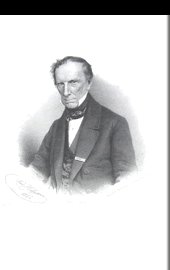A biography of Giovanni Battista Amici
1847-1863 - The immersion object-glass. The Exposition universelle in Paris in 1855. The direct vision prism -  return to index
return to index
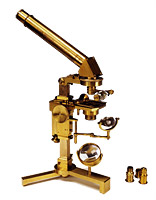 Amici is universally acknowledged with the merit of applying the immersion method with success for the first time, as Ernst Abbe also remembered in 1879 (Ueber Stephenson’s System der homogenen Immersion bei Mikroskop-Objektiven), and 1847 is generally recognized as the date of this fundamental evolution in microscopic optics. The immersion of the lower surface of the objective in a liquid gave Amici’s microscope a hitherto unknown degree of power. The first technical sheet which has been conserved until today of a water-immersion microscope is that of Professor Donders of Utrecht (19 object-glasses), built in the second half of 1849. The VI immersion series has a maximum angular aperture of 90°.
Amici is universally acknowledged with the merit of applying the immersion method with success for the first time, as Ernst Abbe also remembered in 1879 (Ueber Stephenson’s System der homogenen Immersion bei Mikroskop-Objektiven), and 1847 is generally recognized as the date of this fundamental evolution in microscopic optics. The immersion of the lower surface of the objective in a liquid gave Amici’s microscope a hitherto unknown degree of power. The first technical sheet which has been conserved until today of a water-immersion microscope is that of Professor Donders of Utrecht (19 object-glasses), built in the second half of 1849. The VI immersion series has a maximum angular aperture of 90°.
 The first technical sheet dealing with immersion in oil dates from 12 January 1856, and therefore refers to a microscope constructed in 1855 to be sent Rome. The microscope built for Lenoir of Vienna around February 1856, with 18 object-glasses has a water-immersion V series and a VI series which uses “clear white, well-prepared poppy-seed oil. If lacking, this oil can be substituted with sweet almond oil”. Amici also used anise oil, castor oil and glycerine.
The first technical sheet dealing with immersion in oil dates from 12 January 1856, and therefore refers to a microscope constructed in 1855 to be sent Rome. The microscope built for Lenoir of Vienna around February 1856, with 18 object-glasses has a water-immersion V series and a VI series which uses “clear white, well-prepared poppy-seed oil. If lacking, this oil can be substituted with sweet almond oil”. Amici also used anise oil, castor oil and glycerine.
Pieter Harting, who taught Microscopic Anatomy and Vegetal Physiology at Utrecht, had purchased a large achromatic microscope from Amici in 1849. He wrote, in his classic work Das Mikroskop (first Dutch edition 1848-1850), that he considered this instrument as the most perfect from an optical point of view.
In 1852 Amici constructed an achromatic triplet with 6-inch aperture and a 52-inch focal distance based on the new theories of the dioptric systems as elaborated by Mossotti and applied by Angelo Forti.
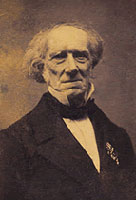 In the 1850s, besides microscopic optics and the perfection of the immersion technique, Amici was also involved first hand in studying illnesses of vines (Oidium), grain rachis, lime disease in silkworms and the diseases of mulberry leaves. In 1852 the Royal Academy of the Georgofili officially added him to the already-formed Commission which was studying the disease infesting the Tuscan vineyards.
In the 1850s, besides microscopic optics and the perfection of the immersion technique, Amici was also involved first hand in studying illnesses of vines (Oidium), grain rachis, lime disease in silkworms and the diseases of mulberry leaves. In 1852 the Royal Academy of the Georgofili officially added him to the already-formed Commission which was studying the disease infesting the Tuscan vineyards.
Most of his writing in those years deal with these topics, all published in the “Atti della R. Accademia Economico-Agraria dei Georgofili di Firenze”: Osservazioni microscopiche sulla malattia dell’uva, Sulla malattia dell’uva, Lettera al Presidente sull’Oidium Tuckeri, Nota del prof. G. B. Amici su fave e vecce, Sulla malattia della foglia del gelso, Lettera del 26 febbraio 1854 intorno all’Oidio della vite, Lettera del 30 luglio 1854 intorno al grano attaccato dalla malattia conosciuta nel Nord di Europa col nome di rachitide (Microscopic observations on the disease of the Vine; On the disease of the Vine; Letter to the President on the Oidium Tuckeri; Notes from Prof. G.B. Amici on broad beans and vetch; On mulberry leaf disease; Letter of 26 February, 1854 about Oidium in vines; Letter of 30 July, 1854 about wheat attacked by the disease known in Northern Europe with the name of rachis).
In 1854, in the fifth volume of the “Annali di Scienze Matematiche e Fisiche”, edited by Barnaba Tortolini, the Elementi parabolici approssimati della cometa (Approximate parabolic elements of the comet) was published.
 In 1855, at 69 years of age, Amici travelled for the third and last time to Paris for the Exposition universelle, where his best object-glasses “duly modified to make them usable with the immersion of the plane surface of the half sphere in water or in poppy seed oil obtained a splendid success”. There is no documentation from this trip, either. We only have indirect information from correspondence. On 10 July
In 1855, at 69 years of age, Amici travelled for the third and last time to Paris for the Exposition universelle, where his best object-glasses “duly modified to make them usable with the immersion of the plane surface of the half sphere in water or in poppy seed oil obtained a splendid success”. There is no documentation from this trip, either. We only have indirect information from correspondence. On 10 July  Duboscq invited him to take part, on Thursday, 12 July, in “une serie d'experiences d’optique à la lumière electrique”. Amici met with Joseph Bourgogne, the first in Europe to create a company of naturalistic preparations scientifically stabilized for micrographic studies, and with Louis Alphonse de Brébisson (1798-1872), French naturalist and photographer. The Gazzetta del Popolo of Florence, on 19 October 1861 (no. 249) provides us with additional information. Based on an interview of Amici on 15 October, the journalist wrote that in 1855 Amici had brought only a small microscope with him to Paris, but that this turned out to be of a much higher quality than the larger and more elegant instruments produced by the Parisian opticians, to the point that these latter were worried about having to display their instruments beside his. With generosity and gallantry Amici declared his intention to renounce the presentation of his microscope at the Exposition and that
Duboscq invited him to take part, on Thursday, 12 July, in “une serie d'experiences d’optique à la lumière electrique”. Amici met with Joseph Bourgogne, the first in Europe to create a company of naturalistic preparations scientifically stabilized for micrographic studies, and with Louis Alphonse de Brébisson (1798-1872), French naturalist and photographer. The Gazzetta del Popolo of Florence, on 19 October 1861 (no. 249) provides us with additional information. Based on an interview of Amici on 15 October, the journalist wrote that in 1855 Amici had brought only a small microscope with him to Paris, but that this turned out to be of a much higher quality than the larger and more elegant instruments produced by the Parisian opticians, to the point that these latter were worried about having to display their instruments beside his. With generosity and gallantry Amici declared his intention to renounce the presentation of his microscope at the Exposition and that
his having been able to progress that precious industry which was the gateway to progress in natural sciences was due to his having found a new method for building object-glasses (immersion in a fluid); and he does not consider himself a better optician for this reason, merely more lucky, and that once other opticians, better constructors and technicians than he, had his discovery in hand, they would easily have surpassed him. [...] Amici was one of the jurists of the Exposition, in the Category where the famous Sir David Brewster was President. This latter did not hesitate to proclaim the superiority of Amici’s microscope; this declaration was, of course, unofficial, and not recorded by the French press, but the English made no mystery of it, as can be seen, e.g., at p. 12 of Hoggs’ beautiful book entitled “The microscope’s history, construction and application”, London, Rowtledge 1859.
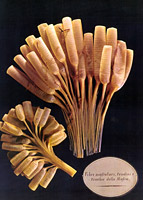 Amici observed and measured the comet of 1858 from his villa with a 240 mm aperture refractor complete with a double-image ocular micrometer. He also wrote the letter Di un nuovo microscopio portatile (On a new pocket microscope) and his important treatise Sulla fibra muscolare (On muscular fibre) during that year; both were published in the newspaper “Il Tempo”.
Amici observed and measured the comet of 1858 from his villa with a 240 mm aperture refractor complete with a double-image ocular micrometer. He also wrote the letter Di un nuovo microscopio portatile (On a new pocket microscope) and his important treatise Sulla fibra muscolare (On muscular fibre) during that year; both were published in the newspaper “Il Tempo”.
In October, 1858 Christian Gottfried Ehrenberg purchased a small microscope for 200 francs in Amici’s workshop in Florence. The same Ehrenberg, when he was Dean of the Faculty of Medicine at the University of Berlin, where August Boeckh was Rector, conferred an honorary degree in Medicine and Surgery on Amici on 16 October, 1860.
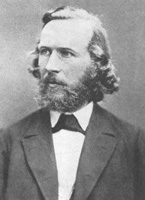 In early 1859 Ernst Haeckel, on his way to Messina, stopped in Florence and bought a small water immersion microscope from Amici for 250 francs. This microscope proved to be useful beyond every hope, because with it Haeckel made the brilliant discoveries which he then published in his monograph Die Radiolarien (1862).
In early 1859 Ernst Haeckel, on his way to Messina, stopped in Florence and bought a small water immersion microscope from Amici for 250 francs. This microscope proved to be useful beyond every hope, because with it Haeckel made the brilliant discoveries which he then published in his monograph Die Radiolarien (1862).
In April 1859, after the Second War of Independence, Leopold II was obliged to abdicate and go into exile in Austria. At the end of that year Amici was relieved of his position as Director of the Astronomical Observatory of the Museum of Physics and Natural History due to his advanced age, as Donati wrote. On 23 December, 1859 Amici was nominated Honorary Professor of Astronomy and Appointee for Microscopic Observations at the Museum of Florence. This appointment was made official in a decree signed by the Prime Minister Bettino Ricasoli and by the Interior Minister Cosimo Ridolfi, who would take over the management of the Museum from Antinori in 1860.
Amici’s last invention, the direct vision prism, has no exact invention date. Between 1857 and 1860 he provided his assistant at the Observatory of the Museum, Giovanni Battista Donati, with an instrument with which he could carry out observations of the striae of stellar spectra. Donati wrote in 1860: “Prof. Amici, in order to make these observations easier (making it easier to point at the stars) has now constructed a prism which offers a large dispersion without deviating the vision axis. This prism is made of three prisms, two of which are of crown glass between which there is a third prism of borosilicate of lead. If you look directly at a fissure or a luminous line with this prism the light is decomposed and the spectrum has the same striae which can be seen through a simple flint glass prism”.
Three Amici microscopes were purchased by the University of Pavia in 1860: a small one with four series of objectives and immersion in water and castor oil for Salvatore Tommasi, Professor of Clinical Medicine, a large one with immersion in water and poppy oil for the botanist Guglielmo Gasparrini to be used in the Institute of Vegetal Anatomy and Physiology, and a third with polarization, immersion in water and anise oil, for the physiological research of Bartolomeo Panizza.
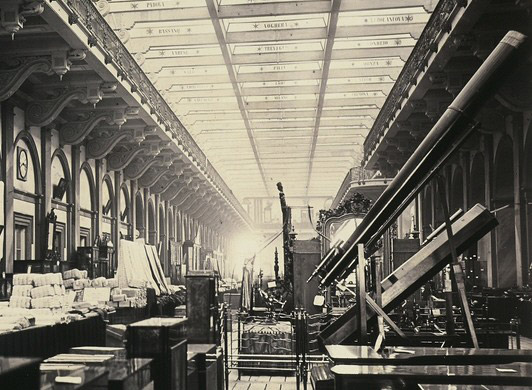
In 1861 Amici was President of the Committee of Jurists for Category IX, Precision Machinery and Physics, at the Italian Exposition held in Florence. With his work, with his production of optical instruments appreciated and imitated internationally (at the time of the Exposition they were the only products with a high technological content, as we would say today, which were exported from Italy), he demonstrated that the work of the scientist and that of the instrument maker had to go forward in synergy. He also inaugurated the modern tradition of Florentine optics which led to the creation in 1870, thanks to Donati’s work, of the Officina Galileo.
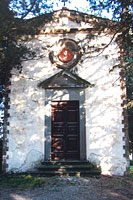 From the papers kept at the Estense Library in Modena we learn that Amici was most probably a Senator in Tuscany from 1846 to 1849.
From the papers kept at the Estense Library in Modena we learn that Amici was most probably a Senator in Tuscany from 1846 to 1849.
The last entry written personally by him in the Workshop account book (Libro de’ conti del laboratorio), dated 25 March 1863, was for the sale of a small microscope.
On 10 April of that year, in Florence, the long and intense life of Giovanni Battista Amici came to an end.
A crater of 54km in diameter on the hidden face of the moon (lat. 9.9° S, long. 172.1° W) and the small planet 3809 are both named after him.
Bibliography
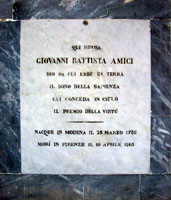 Jabez Hogg, The microscope: its history, construction, and application, Third Edition, Routledge, London 1858, p. 12, note; G. B. Donati, Intorno alle strie degli spettri stellari, “Il Nuovo Cimento”, Tomo XV-1862; F. Palermo, Sulla vita e le opere di Giovanni Battista Amici, “Bullettino di bibliografia e di storia delle scienze matematiche e fisiche”, tomo III, Roma 1870; C. Morais, Su di un obbiettivo costruito dall’Amici secondo la teoria del Mossotti, “Physis”, 2-1965; E. Proverbio, The Production of Achromatic Objectives in the First Half of the Nineteenth Century: The Contributions of Giovanni Battista Amici, “Memorie della Società astronomica italiana”, LXI-1990; A. Meschiari, Corrispondenza di Giovanni Battista Amici con Ottaviano Fabrizio Mossotti, “Atti della Fondazione Giorgio Ronchi”, 5-1999; A. Meschiari, Come nacque l’Officina Galileo di Firenze. Gli anni 1861-1870, Fondazione Giorgio Ronchi, vol. LXXXV, Firenze 2005.
Jabez Hogg, The microscope: its history, construction, and application, Third Edition, Routledge, London 1858, p. 12, note; G. B. Donati, Intorno alle strie degli spettri stellari, “Il Nuovo Cimento”, Tomo XV-1862; F. Palermo, Sulla vita e le opere di Giovanni Battista Amici, “Bullettino di bibliografia e di storia delle scienze matematiche e fisiche”, tomo III, Roma 1870; C. Morais, Su di un obbiettivo costruito dall’Amici secondo la teoria del Mossotti, “Physis”, 2-1965; E. Proverbio, The Production of Achromatic Objectives in the First Half of the Nineteenth Century: The Contributions of Giovanni Battista Amici, “Memorie della Società astronomica italiana”, LXI-1990; A. Meschiari, Corrispondenza di Giovanni Battista Amici con Ottaviano Fabrizio Mossotti, “Atti della Fondazione Giorgio Ronchi”, 5-1999; A. Meschiari, Come nacque l’Officina Galileo di Firenze. Gli anni 1861-1870, Fondazione Giorgio Ronchi, vol. LXXXV, Firenze 2005.
